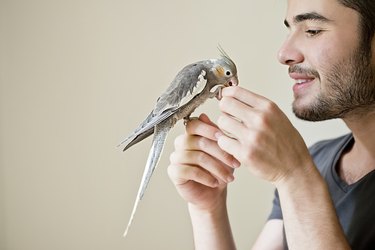
Sometimes the mood of a pet bird is difficult to read. Happy or sad, moody or mad — you can decipher bird behaviors by observing the bird's body language. These signs can be obvious or subtle, and they can always give you insight into your bird's wants and needs.
Bird body language
Video of the Day
All birds communicate through different types of bird body language, but some behaviors can be seen in most pet birds just by observing your bird's vocalizations, wings, tail, beak, and eyes — and can be very telling. Some of these behaviors are displayed a lot more in some types of birds and stand out best in others.
Video of the Day
The eyes are the key
In a bird's case, eyes are the key. Unlike humans, a bird can control its irises. By enlarging and shrinking their irises, the bird can display its interest in something, when they're angry, afraid, or in the fighting mood. This eye action is labeled "flashing" or "pinning."
Vocal communications
Most birds are vocal and in the wild vocalizations are used for warnings, attracting mates, territorial protection, and continuing social contact with other birds. But don't overlook the signs when your bird may be attempting to contact you!
The happy signs
Did you ever hear your bird sing, talk, or whistle? These are signs of a happy, healthy, and content bird. Of course, you'll have those birds that love an audience and sing like mad when there are people around as opposed to the quiet bird who'll only sing for you. Regardless of which bird you have, if you hear a song, a whistle, or some words, you'll know your bird is happy.
What is bird chatter?
Whether soft or loud, a bird's chatter can be a sign your bird is content. However, the chatter may just be your bird learning to talk. Sometimes a bird will chatter loudly to get your attention. Wild birds chatter in the evening, before sleeping, to connect with other members of their flock.
Purring, growling, and clicking
A parrot purring is more like a soft growl and not like a cat's purr. This vocalization can either be a sign of contentment or annoyance. To read what the bird is saying, it's best to factor in the environment and body language of the bird. The real growl which isn't heard in all pet birds is a sign of aggression. If your bird growls, examine its environment and remove anything she doesn't like. A note of caution here — growling birds shouldn't be handled!
On the other end of the spectrum, we have tongue clicking. When a bird clicks its tongue against her beak, she may be asking for you to pick her up and pet her.
Wing flipping, flapping, and drooping
Not always meant for flight, the wings of a bird are also used for communication. Flying in place or wing flapping is used as exercise, to get your attention, or just to display happiness. Sometimes a bird will lift its wings to cool itself or stretch. Wing flipping can mean a variety of things from anger to pain, but it may also be your bird fluffing its feathers to get them to lay just right for them. When flipping is accompanied by a head bob (an attention getter) your bird often wants food! Note that flipping is also associated with mating behavior.
Often when a bird learns to fly, they must also learn to fold and tuck their wings. Drooping their wings allows them to learn how to fold and tuck. When an older bird does this, it could indicate illness. Also, drooping is done in conjunction with drying their wing feathers after bathing.
And speaking of feathers
How a bird holds its feathers is an important aspect of body language. During the preening process, birds will ruffle or flare their feathers. This will aid in removing all dirt and dust to allow their feathers to return to their normal position. A bird ruffling feathers is also a way it can remove tension after preening, but if feathers remain ruffled, take caution — this may be a sign of illness. Tail feather flaring is when a bird spreads out its tail like a fan. Usually displayed by parrots, and often with eye pinning, tail flaring means your bird is in a highly excited state.
Crest feathers
Birds like cockatiels and hawk-headed parrots have crest feathers they can lower or raise. This is an action to display an emotional state. Observe what will prompt your bird to raise or lower its crest. See if it fears something or someone's relationship, or if it's happy or sad.
The quiet bird
There is no such thing as a quiet bird! Some birds are quieter than others but usually, the bigger the bird, the noisier it is. Noise-making is instinctual for a bird so do not expect complete quietness always. Noise is how birds communicate, defend themselves, and form bonds.
Observe your bird
Watch and study your bird, learn its patterns, and what he is trying to tell you. Sometimes you may sense a sign of illness, often you won't know your bird is sick. not. But if you do uncover some unusual behavior not normally displayed by your bird, you will want to take flight to your local veterinarian.